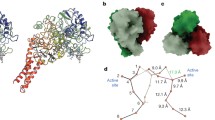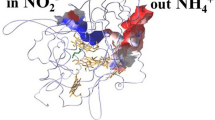Abstract
When grown with nitrate as terminal electron acceptor both the soluble (periplasm, cytoplasm) and the membrane fraction of “Spirillum” strain 5175 exhibited high nitrite reductase activity. The nitrite reductase obtained from the soluble fraction was purified 76-fold to electrophoretical homogeneity. The enzyme reduced nitrite to ammonia with a specific activity of 723 μmol NO sup-inf2 × (mg protein × min)-1. The molecular mass was 58±1 kDa by SDS-PAGE compared to 59±2 kDa determined by size exclusion chromatography under nondenaturing conditions. The enzyme (as isolated) contained 5.97±0.15 heme c molecules/Mr 58 kDa. The absorption spectrum was typical for c-type cytochrome with maxima at 280, 408, 532 and 610 nm (oxidized) and at 420, 523 and 553 nm (dithionite-reduced). The enzyme (as isolated) exhibited a complex set of high-spin and lowspin ferric heme resonances with g-values at 9.82, 3,85, 3.31, 2.95, 2.30 and 1.49 in agreement with data reported for electron paramagnetic resonance spectra of nitrite reductases from Desulfovibrio desulfuricans, Wolinella succinogenes and Escherichia coli.
Similar content being viewed by others
Abbreviations
- DNRA:
-
dissimilatory nitrate reduction to ammonia
- EPR:
-
electron paramagnetic resonance
- PAGE:
-
polyacrylamide gel electrophoresis
- NaPi :
-
sodium phosphate
- SDS:
-
sodium dodecylsulfate
References
Barton LL, LeGall J, Odom M, PeckJr HD (1983) Energy coupling to nitrite respiration in the sulfate-reducing bacterium Desulfovibrio gigas. J Bacteriol 153: 867–871
Blackmore R, Roberton AM, Brittain T (1986) The purification and some equilibrium properties of the nitrite reductase of the bacterium Wolinella succinogenes. Biochem J 233: 547–552
Blackmore RS, Brittain T, Gadsby PMA, Greenwood C, Thomson AJ (1987) Electron paramagnetic resonance and magnetic circular dichroism studies of a hexa-heme nitrite reductase from Wolinella succinogenes FEBS Lett 219: 244–248
Brittain T, Greenwood C (1975) A comparative study of some kinetic and spectral properties of guanidinated and native cytochrome c. Biochem J 147: 175–177
Costa C, Moura JJG, Moura I, Liu M-Y, PeckJr HD, LeGall J (1990) Hexaheme nitrite reductase from Desulfovibrio desulfuricans. Mössbauer and EPR characterization of the heme groups. J Biol Chem 265: 14382–14387
Fuhrhop J-H, Smith KM (1975) Preparation of metalloporhyrins from porphyrins and isolation from natural sources. In: Smith KM (ed) Porphyrins and metalloporphyrisn. Elsevier, Amsterdam New York, pp 757–861
Gudat JC, Shing J, Wharton DC (1973) Cytochrome oxidase from Pseudomonas aeruginosa. I. Purification and some properties. Biochim Biophys Acta 292: 376–390
Heukeshoven J, Dernick R (1985) Simplified method for silver staining of proteins in polyacrylamide gels and mechanism of silver staining. Electrophoresis 6: 103–108
Janick PA, Siegel LM (1983) Electron paramagnetic resonance and optical evidence for interaction between siroheme and Fe4S4 prosthetic groups in complexes of Escherichia coli sulfite reductase hemoprotein with added ligands. Biochemistry 22: 504–515
Kajie S-I, Anraku Y (1986) Purification of a hexaheme cytochrome c 552 from Escherichia coli K 12 and its properties as a nitrite reductase. Eur J Biochem 154: 457–463
Kakutani T, Watanabe H, Arima K, Beppu T (1981) Purification and properties of a copper-containing nitrite reductase from a denitrifying bacterium Alcaligenes faecalis strain S-6. J Biochem 89: 453–461
Laemmli (1970) Cleavage of structural proteins during the assembly of the head of bacteriophage T4. Nature 227: 680–685
Liu M-C, Peck HDJr (1981) The isolation of a hexaheme cytochrome from Desulfovibrio desulfuricans and its identification as a new type of nitrite reductase. J Biol Chem 256: 13159–13164
Liu M-C, Liu M-Y, Payne WJ, Peck HDJr, LeGall J, DerVartanian DV (1987) Comparative EPR studies on the nitrite reductases from Escherichia coli and Wolinella succinogenes. FEBS Lett 218: 227–230
Liu M-C, Bakel BW, Liu M-Y, Dao TN (1988) Purification of Vibrio fischeri nitrite reductase and its characterization as a hexaheme c-type cytochrome. Arch Biochem Biophys 262: 259–265
Massey V, Hemmerich P (1978) Photoreduction of flavoproteins and other biological compounds catalyzed by deazaflavins. Biochemistry 17: 9–17
Riester J, Zumft WG, Kroneck PMH (1989) Nitrous oxide reductase from Pseudomonas stutzeri. Redox properties and spectroscopic characterization of different forms of the multicopper enzyme. Eur J Biochem 178: 751–762
Sadana JC, Khan BM, Fry IV, Cammack R (1986) Electron paramagnetic resonance studies of heme c and its nitrosyl derivative in Vibrio (Achromobacter) fischeri nitrite reductase. Biochem Cell Biol 64: 394–399
Schroeder WA, Shelton JR, Shelton JB, Robberson B, Apell G, Fang RS, Bonaventura J (1982) The complete amino acid sequence of bovine liver catalase and the partial sequence of bovine erythrocyte catalase. Arch Biochem Biophys 214: 397–421
Smith PK, Krohn RI, Hermanson GT, Mallia AK, Gartner FH, Provenzano MD, Fujimoto EK, Geoke NM, Olson BJ, Klenk DC (1985) Measurement of protein using bicinchoninic acid. Anal Biochem 150: 76–85
Tiedje JM (1988) Ecology of denitrification and dissimilatory nitrate reduction to ammonium. In: Zehnder AJB (ed) Biology of anaerobic microorganisms. Wiley, New York Chechester Brisbane Toronto Singapore, pp 179–244
Widdel F (1986) Growth of methanogenic bacteria in pure culture with 2-propanol and other alcohols as hydrogen donor. Appl Environ Microbiol 51: 1056–1062
Wolfe RS, Pfenning N (1977) Reduction of sulfur by spirillum 5175 and syntrophism with Chlorobium. Appl Environ Microbiol 33: 427–433
Zöphel A, Kennedy MC, Beinert H, Kroneck PMH (1988) Investigations on microbial sulfur respiration. 1. Activation and reduction of elemental sulfur in several strains of eubacteria. Arch Microbiol 150: 72–77
Zöphel A, Kennedy MC, Beinert H, Kroneck PMH (1991) Investigations on microbial sulfur respiration. 2. Isolation, purification, and characterization of cellular components from Spirillum 5175. Eur J Biochem 195: 849–856
Author information
Authors and Affiliations
Rights and permissions
About this article
Cite this article
Schumacher, W., Kroneck, P.M.H. Dissimilatory hexaheme c nitrite reductase of “Spirillum” strain 5175: purification and properties. Arch. Microbiol. 156, 70–74 (1991). https://doi.org/10.1007/BF00418190
Received:
Accepted:
Issue Date:
DOI: https://doi.org/10.1007/BF00418190




